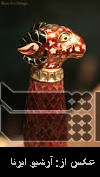Ahmad Adib added that out of 366 handicrafts across the country, Isfahan province accounts for 196. “There are 30,000 handicraft workshops (with the exclusion of gold, jewelries and carpet) across Isfahan.”
Adib said nearly 5,000 craftsmen from Isfahan have been covered by insurance services since 2008. He noted that Isfahan Handicrafts Department has held trainings courses for 4,000 trainees.
Shawl weaving, enameled tile, jeweled enameled items, traditional glass blowing, and gold or sliver lace are some of the obsolete fields.
International organizations believe Iran has the most diverse and highest quality handicrafts in the world. At present, China’s production is more than Iran’s, but Iran’s diversity and quality are higher.
Studies have confirmed that Iran is the birthplace of various handicrafts like carpet, metal works, pottery and ceramics. These exquisite Iranian artworks are displayed in museums and artistic centers of the world. In fact, handicrafts can be used as a cultural tool to promulgate the Iranian and Islamic culture worldwide. Handicrafts are cultural products that facilitate the transfer of Iranian beliefs, traditions and rituals to other countries.
**1425

Tehran, July 1, IRNA - Thirteen handicrafts have become obsolete and 21 others are on the verge of extinction, said the deputy head of Isfahan Cultural Heritage, Handicrafts and Tourism Department.

